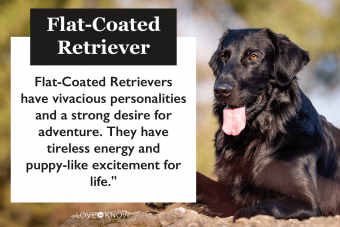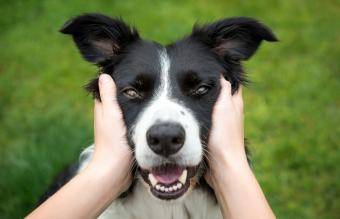
Flat-Coated Retrievers are commonly referred to as the "Peter Pan" Retriever. They mature at a slower rate than other dogs and retain their puppy-like enthusiasm for many years. These dogs are renowned for their rambunctious, happy attitudes, and also their fondness for water.
Flat-Coated Retriever Origins
The Flat-Coated Retriever originated in the United Kingdom and was formerly the most popular retriever in the country. Because they were common occupants of British upper class estates, they were known as the "Gamekeeper's Dog." The breed is a cross between retrievers and setters. In 1915, the American Kennel Club (AKC) recognized the breed.
Until the end of World War I, the Flat-Coated Retriever was a popular hunting dog, but Labrador and Golden Retrievers began to take their place in popularity. Their population dwindled to dangerously low levels, and the breed came close to extinction on a few occasions. By the mid-1960s, the Flat-Coated Retriever's admirers rallied to bring the breed back from the edge. Although Flat-Coated Retrievers never regained their former popularity, breeders see this as a positive. It has aided in preserving the breed's natural abilities, intelligence, and wonderfully goofy personality.
The Flat-Coated Retriever is still a rare breed, ranking 100th out of 155 certified breeds and variants by the American Kennel Club.
How Are Flat-Coated Retrievers Different From Other Retriever Breeds?

Flat-Coated Retrievers and other retrievers, such as the Labrador Retriever and Golden Retriever, have a lot in common. Flat-Coats, like their Retriever counterparts, are highly energetic, active, and intelligent dogs who enjoy working. They also enjoy splashing around in water, even in freezing weather, and make good hunting partners. Flat-Coated Retrievers are distinguished from other retriever breeds in several ways:
- Their coat is "flatter" and straighter (per their name) compared to a Golden Retriever.
- Their coat is longer than that of a Labrador Retriever and only comes in black or liver coloring.
- Unlike other retrievers, such as the Labrador Retriever and Golden Retriever, this breed does not have "show" and "field" variant lines.
- Despite the fact that they are recognized by the AKC, they are not as popular as other retrievers. The Labrador Retriever and Golden Retriever are currently ranked first and third in AKC breed popularity in the United States, respectively, whereas the Flat-Coated Retriever is ranked 91st.
- Their exercise requirements are higher than those of other retrievers.
- Flat-Coated Retrievers are more likely than other retrievers to develop fatal cancers. Cancer in Flat Coat Retrievers as young as four years old is not uncommon.
Characteristics
A male Flat-Coated Retriever stands between 23 and 24.5 inches tall at the shoulder, while a female stands between 22 and 23.5 inches. Flat-Coated Retrievers weigh 55 to 70 pounds on average. The AKC describes them as having a "one-piece head" because the bridge of the nose (the dip between the nose and the forehead) is nearly nonexistent. As it transitions from the muzzle to the back of the skull, the Flat-Coated Retriever's skull appears to be continuous. Overall, they have a powerful, athletic frame, but it isn't as broad as a Labrador Retriever.
Coat

Only solid black or liver coloring are present, and the Flat-Coated Retriever's coat is normally straight and flat against the body, however some may have wavier hair. Their tail and legs are also covered in beautiful feathering. Their long coat is actually very easy to care for, requiring only a weekly brushing and combing. Regular ear cleaning is also recommended, since their floppy ears and feathery coat, combined with swimming, can cause ear infections. They are a shedding breed, so grooming them on a regular basis can help keep their coat healthy, and keep fur on your furniture and around the home to a minimum.
Breed Temperament
The Flat-Coated Retriever has an ever-youthful view on life. They have a lot of good qualities. They are intelligent, personable, adaptive, and upbeat. With a moderately strong activity level, they are also mischievous and cheerful. Flat-Coated Retriever exercise requirements must be met in order for them to maintain their pleasant, peaceful demeanors.
This is a slow-maturing breed. Flat-Coated Retrievers act like puppies for several years after reaching physical maturity. They are a delicate breed that does not react well to harsh training. They may become obstinate or simply refuse to do anything you ask until you make them feel better. Positive training methods are critical for any breed, but this breed is particularly sensitive to harsh training methods.
They adore meeting new people and will always consider strangers their new greatest pals. They get along nicely with other dogs and pets. If you have a cat, they generally get along, especially if they were introduced at a young age. Flat-Coated Retrievers can also make perfect family dogs, though their energy level may be too much for young children or the elderly. A Flat-Coated Retriever is an outgoing, affectionate, and tireless companion who adapts best to an active home life.
Exercise Needs

Like all retrievers, Flat-Coated Retrievers require a lot of daily exercise. This entails a decent 30-minute jog at least twice a day, at a minimum. Providing an hour of strenuous activity every day is strongly advised to ensure that their needs are satisfied. They can easily turn destructive in the home if their needs aren't satisfied. These are dogs who require some form of physical, "working" activity, such as hunting, hiking, and swimming, or practicing dog sports such as dock diving and agility.
Training
Flat-Coated Retrievers are a dream to train because they are incredibly food-driven and people-oriented. Use positive reinforcement strategies such as praise, play, and food rewards, and don't forget to be kind and consistent. They like trying new things and are capable of excelling in a variety of canine sports, including competitive obedience, scent work, agility, and more. They can also make wonderful therapy dogs, however you'll want to make sure you've taught them to greet people respectfully rather than rushing at them with their enthusiastic, energy-filled greeting.
Health Concerns
The average lifespan of a Flat Coat Retriever is about 10 to 12 years. Like most large, sporting dogs, Flat Coats can suffer from hip dysplasia and arthritis. Other health concerns include:
- Bloat, or gastric torsion, is a twisting of the stomach that can be fatal if not treated immediately.
- Cancer is the cause of death in about 60% of Flat Coat Retrievers, and common forms of cancer in the breed are histiocytic sarcoma, lymphosarcoma, hemangiosarcoma, and osteosarcoma.
- Epilepsy and accompanying seizures, which can be severe.
- Heart disease and canine congestive heart failure which can happen at any age.
- Eye problems such as glaucoma, cataracts and progressive retinal atrophy can someday lead to vision loss and even blindness.
Where Can You Get a Flat-Coated Retriever?

The Flat-Coated Retriever Society of America is the ideal organization to help you find a respectable breeder if you want to welcome a Flat-Coated Retriever puppy into your home. Remember, they are rare, so you may be placed on a waiting list. A list of breeder members is available on the website. A purebred Flat-Coated Retriever puppy costs from $1,300 to $1,800 in the United States.
Rescuing a Flat-Coated Retriever
Because the breed is not as popular as other types of retrievers, they may be a bit harder to find in a rescue. The Flat-Coated Retriever Society of America runs a Facebook page for rescue listings and has a list of regional rescue contacts on their website. You can also visit Petfinder and Adopt-a-Pet to do a search on the breed to see if any all-breed rescues or shelters have one available for adoption.
Is This Breed the Right Dog for You?
A Flat-Coated Retriever may be a good fit for your home if you're an active, energetic person looking for a canine partner to match. They're joyful dogs who stay "puppylike" for longer than other breeds, and they excel at a variety of activities and dog sports. Just make sure you have the stamina to keep up with their zest for life!







